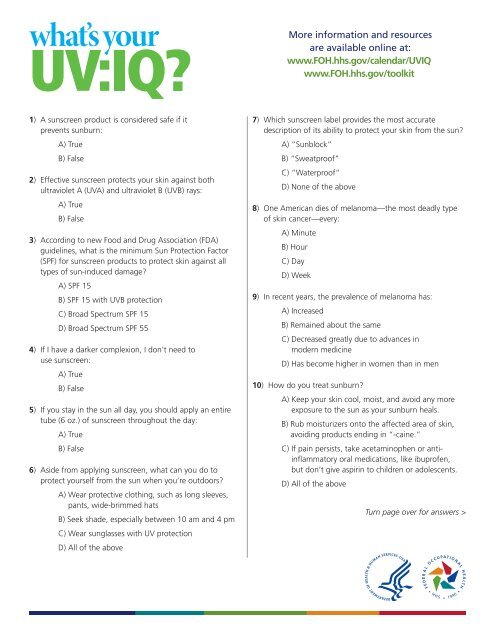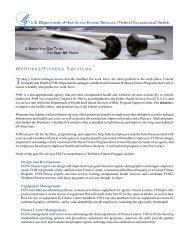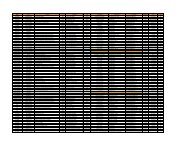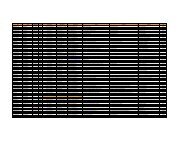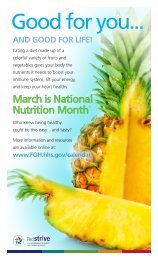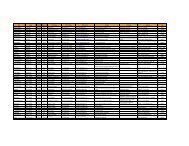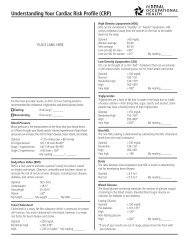Create successful ePaper yourself
Turn your PDF publications into a flip-book with our unique Google optimized e-Paper software.
More information and resourcesare available online at:www.FOH.hhs.gov/calendar/<strong>UV</strong>IQwww.FOH.hhs.gov/toolkit1) A sunscreen product is considered safe if itprevents sunburn:A) TrueB) False2) Effective sunscreen protects your skin against bothultraviolet A (<strong>UV</strong>A) and ultraviolet B (<strong>UV</strong>B) rays:A) TrueB) False3) According to new Food and Drug Association (FDA)guidelines, what is the minimum Sun Protection Factor(SPF) for sunscreen products to protect skin against alltypes of sun-induced damage?A) SPF 15B) SPF 15 with <strong>UV</strong>B protectionC) Broad Spectrum SPF 15D) Broad Spectrum SPF 554) If I have a darker complexion, I don’t need touse sunscreen:A) TrueB) False5) If you stay in the sun all day, you should apply an entiretube (6 oz.) of sunscreen throughout the day:A) TrueB) False6) Aside from applying sunscreen, what can you do toprotect yourself from the sun when you’re outdoors?A) Wear protective clothing, such as long sleeves,pants, wide-brimmed hatsB) Seek shade, especially between 10 am and 4 pmC) Wear sunglasses with <strong>UV</strong> protectionD) All of the above7) Which sunscreen label provides the most accuratedescription of its ability to protect your skin from the sun?A) “Sunblock”B) “Sweatproof”C) “Waterproof”D) None of the above8) One American dies of melanoma—the most deadly typeof skin cancer—every:A) MinuteB) HourC) DayD) Week9) In recent years, the prevalence of melanoma has:A) IncreasedB) Remained about the sameC) Decreased greatly due to advances inmodern medicineD) Has become higher in women than in men10) How do you treat sunburn?A) Keep your skin cool, moist, and avoid any moreexposure to the sun as your sunburn heals.B) Rub moisturizers onto the affected area of skin,avoiding products ending in “-caine.”C) If pain persists, take acetaminophen or antiinflammatoryoral medications, like ibuprofen,but don’t give aspirin to children or adolescents.D) All of the aboveTurn page over for answers >
More information and resourcesare available online at:www.FOH.hhs.gov/calendar/<strong>UV</strong>IQwww.FOH.hhs.gov/toolkit1) FalseSunscreen that prevents sunburn alone does not save yourskin from all the harmful effects of the sun.Sunscreens that only protect against sunburn do not necessarilyprotect against the deep-penetrating ultraviolet A (<strong>UV</strong>A) raysthat can cause damage to the deeper layers of skin that canlead to cancerous tissue growth and promote early aging.2) TrueProtection against both types of <strong>UV</strong> rays are necessary. <strong>UV</strong>Arays penetrate into the thickest layer of skin, the dermis, andcan weaken the immune system’s ability to protect againstskin cancer. <strong>UV</strong>A rays also promote premature aging of theskin. <strong>UV</strong>B rays reach only the surface layer of skin and arethe primary cause of sunburn.3) C – Broad Spectrum SPF 15New regulations from the FDA require sunscreen productsthat protect against all types of sun-induced skin damage tobe labeled “broad spectrum” and “SPF 15” (preferably SPF30 or higher). D is incorrect because there is no evidence foradditional benefits of using products with SPF values over 50.4) FalseEven though people with light complexions are at highest riskfor skin cancer, people with darker complexions are still at risk.Melanin is a pigment found in the top layers of the skin—the higher the amount of melanin, the darker the skin’s tone.Even though higher amounts of melanin offer some protectionfrom sun-induced skin damage, it doesn’t fully protect againstsunburn or skin cancer. Wearing broad-spectrum sunscreen,going for shade, and wearing protective clothing during peakburning hours can help lower anyone’s risk.5) True“Most people apply only 25 to 50 percent of the recommendedamount of sunscreen,” reports the American Academy ofDermatology. It is advised you put on an ounce of sunscreen30 minutes prior to going outdoors and reapply this sameamount about every two hours when exposed to the sun.Don’t wait until you start to burn!6) D – All of the AboveMerely applying sunscreen is not enough! All of these skinprotectionmethods are necessary, as no one method aloneis enough to keep your skin and eyes safe. For example,clothing provides an SPF less than 15, according to theCenters for Disease Control and Prevention (CDC). Widebrimmedhats can shield your face and your eyes, whilesunglasses offer much needed protection for the eyes.7) D – None of the AboveAccording to the FDA, sunscreens can only “resist water”or “screen” the sun’s rays, not block them.8) B – HourMelanoma is kills a person every hour in the United States. Infact, according to the National Cancer Institute, it’s estimatedthat 9,180 people will die of melanoma of the skin in 2012.9) A – IncreasedWhile many cancer rates are declining in the United States, theincidence of melanoma has continued to increase. Accordingto the CDC, the diagnoses of melanoma have increased by 2.3percent per year for men and 2.5 percent per year for womenfrom 1999 through 2008 (the most recent data available).10) D – All of the AboveAll of these options will promote the slow healing process ofsunburn. Remember don’t give children or adolescents aspirin,because of the risk of Reyes Syndrome. Also, avoid creams andlotions with ingredients ending in “-caine,” such as benzocaineor lidocaine. Such products have the potential to irritate theskin further. They may also cause rare, but serious, medicalcomplications, especially for children and adolescents.The best thing to do is allow your skin to heal on its ownand at its own pace. According to the American Academy ofDermatology, it is essential to keep skin that is recovering outof the sun, especially if your outer layer of skin is peeling or haspeeled off. Contact your health care provider if you have anycomplications like extreme blistering or signs of an infection.


